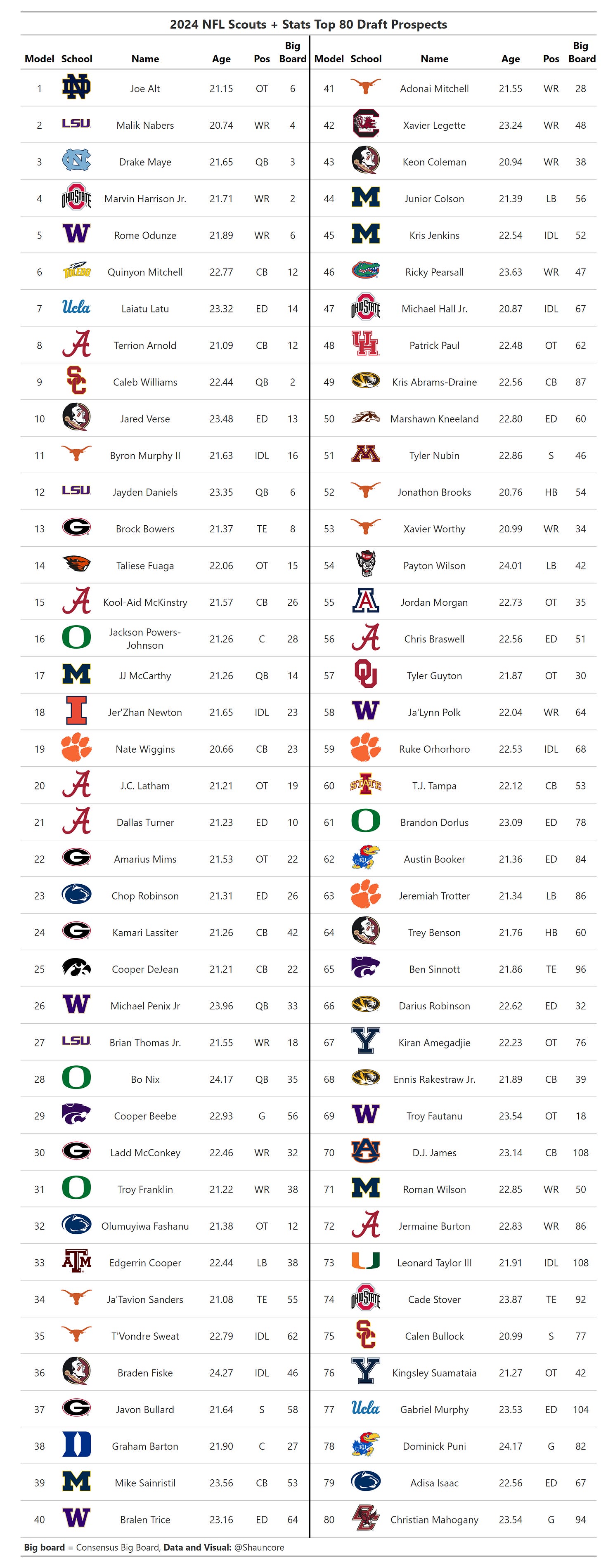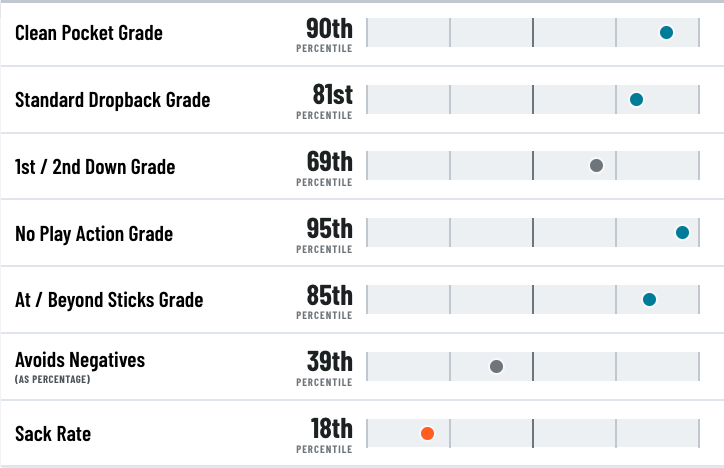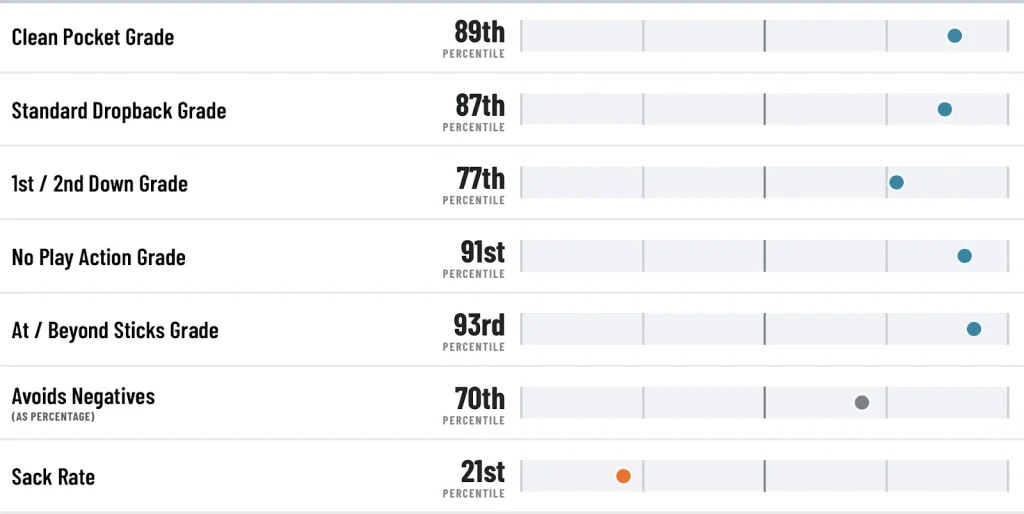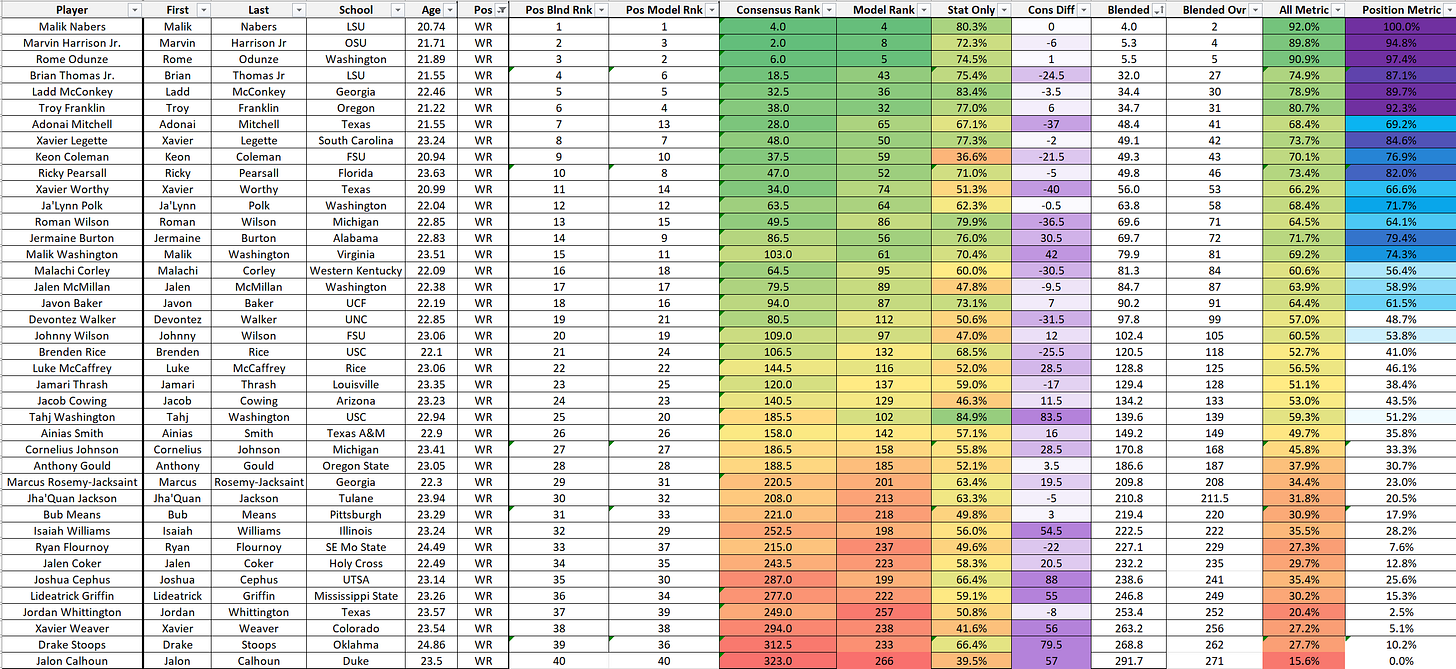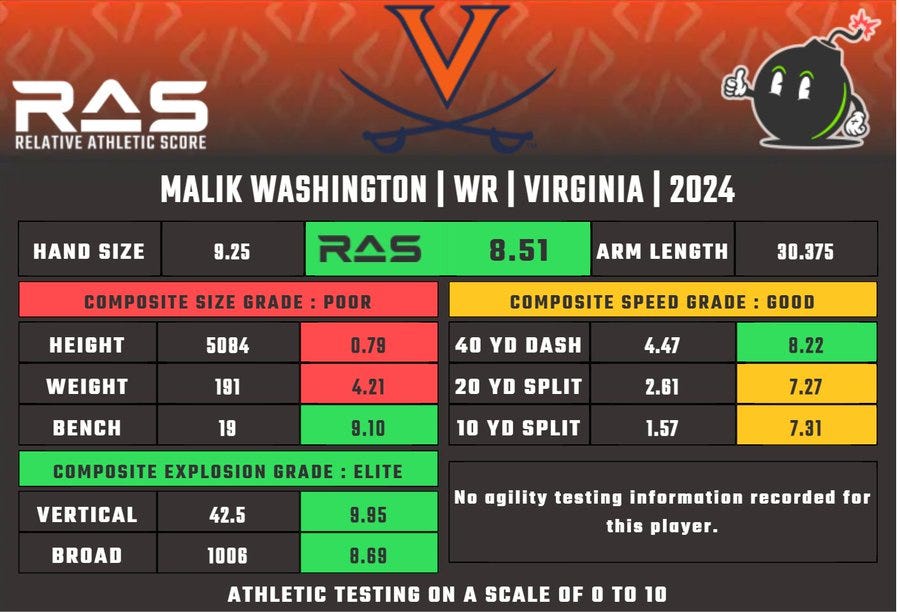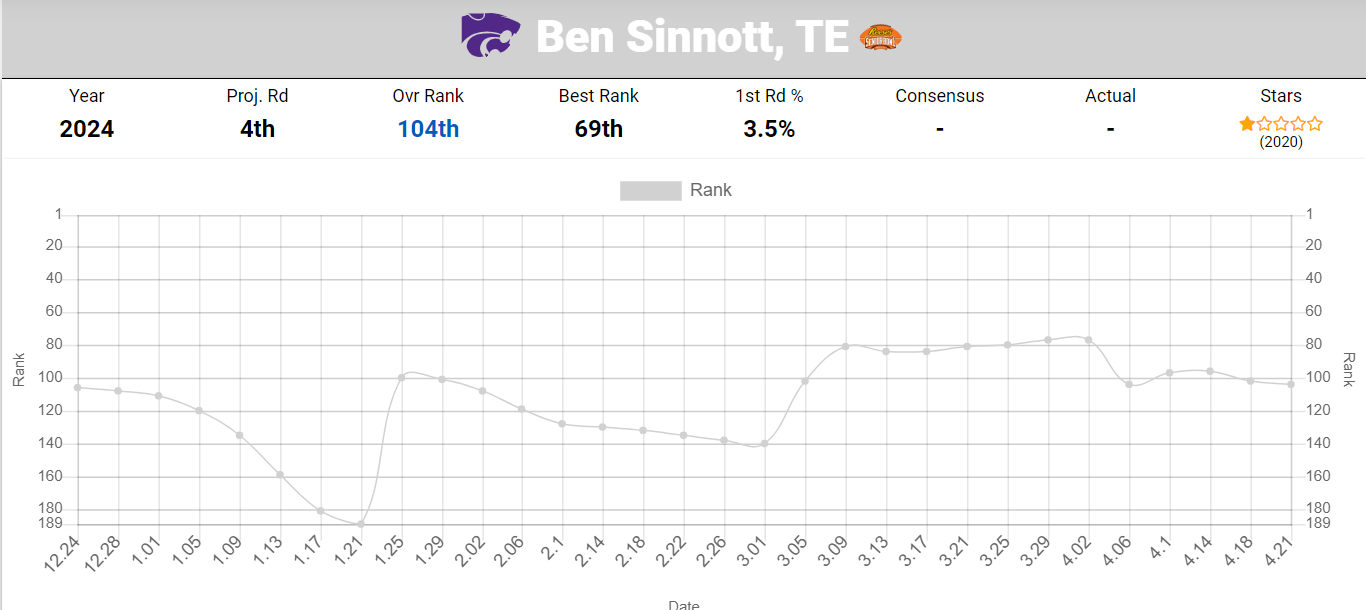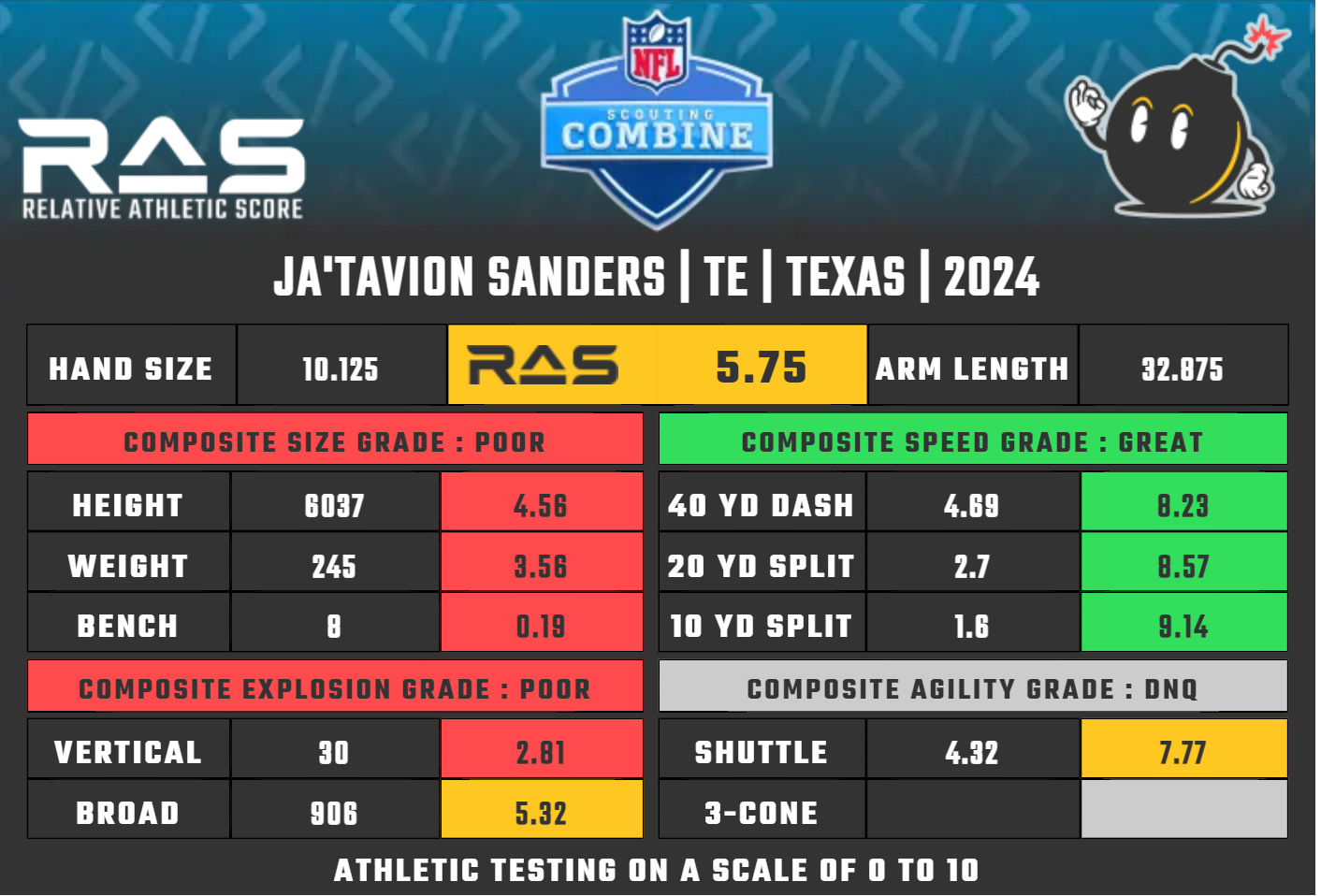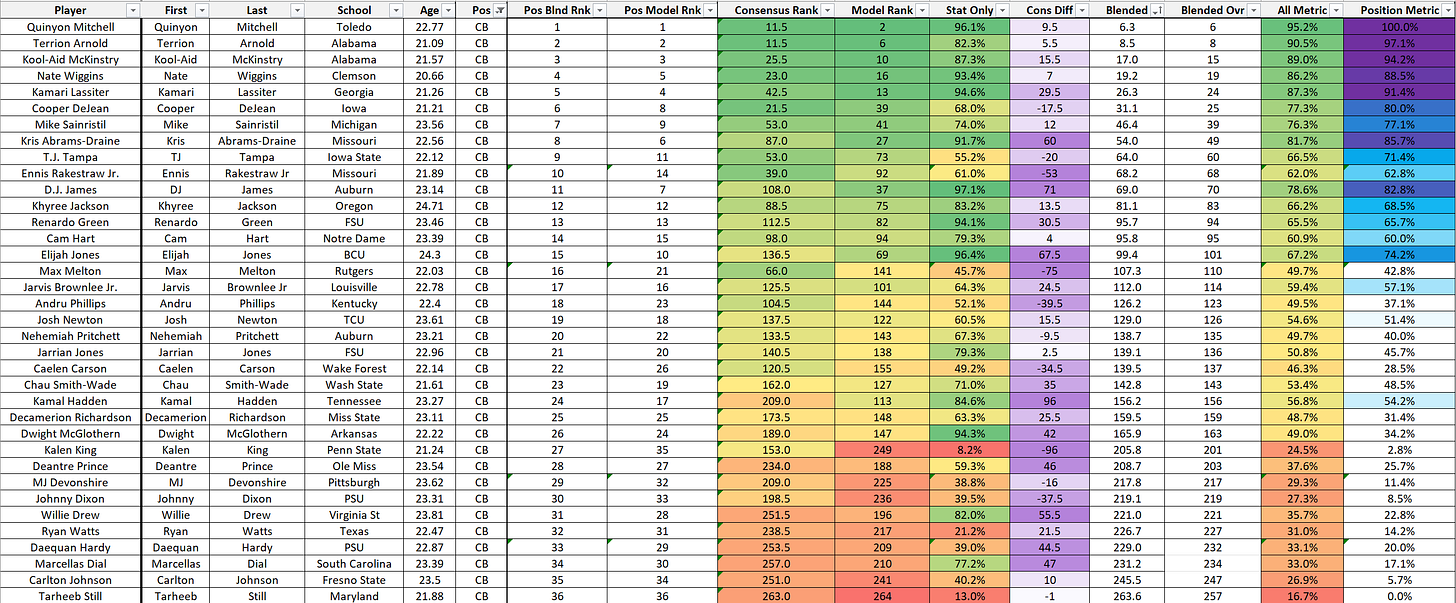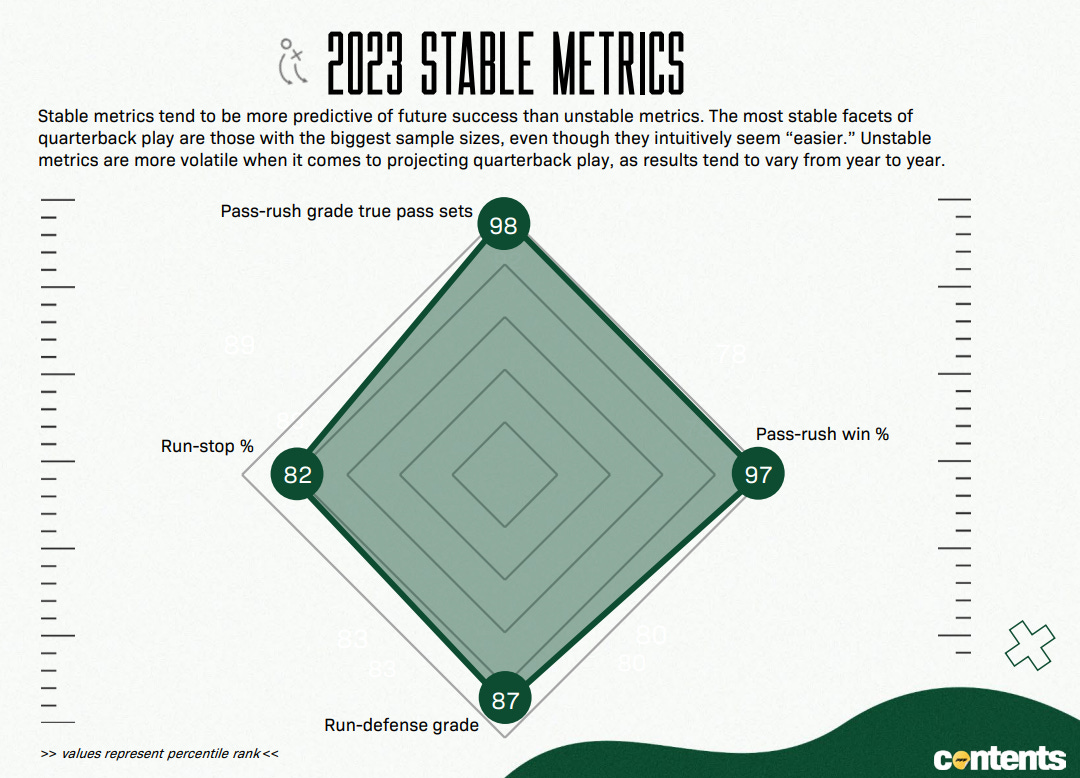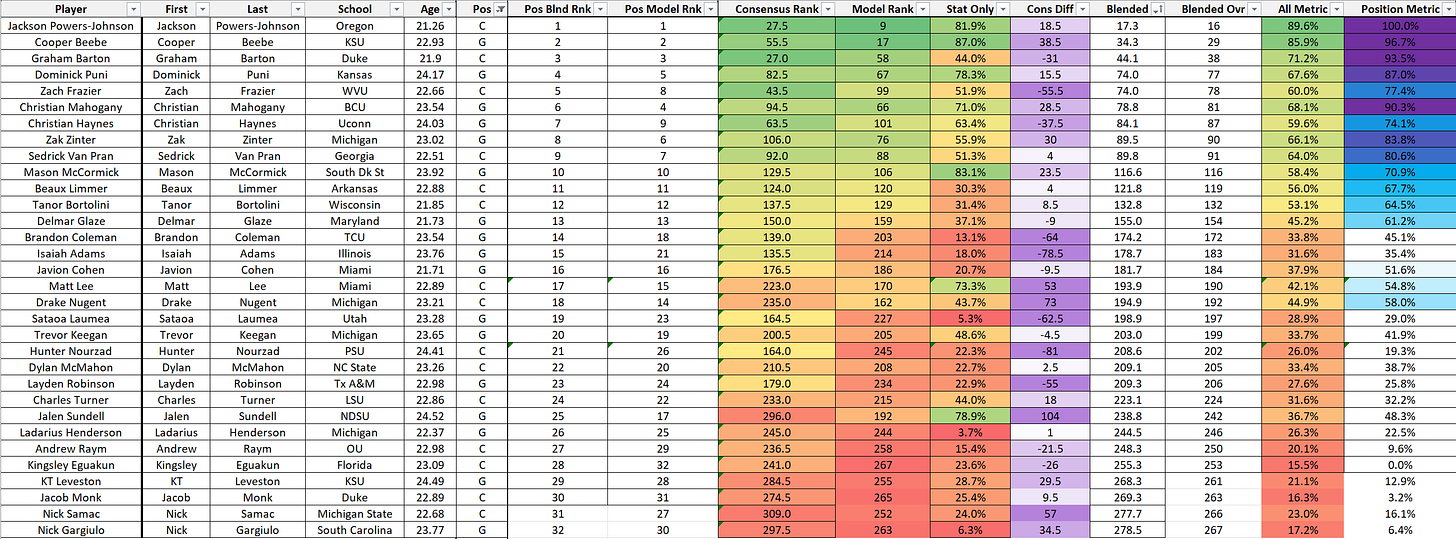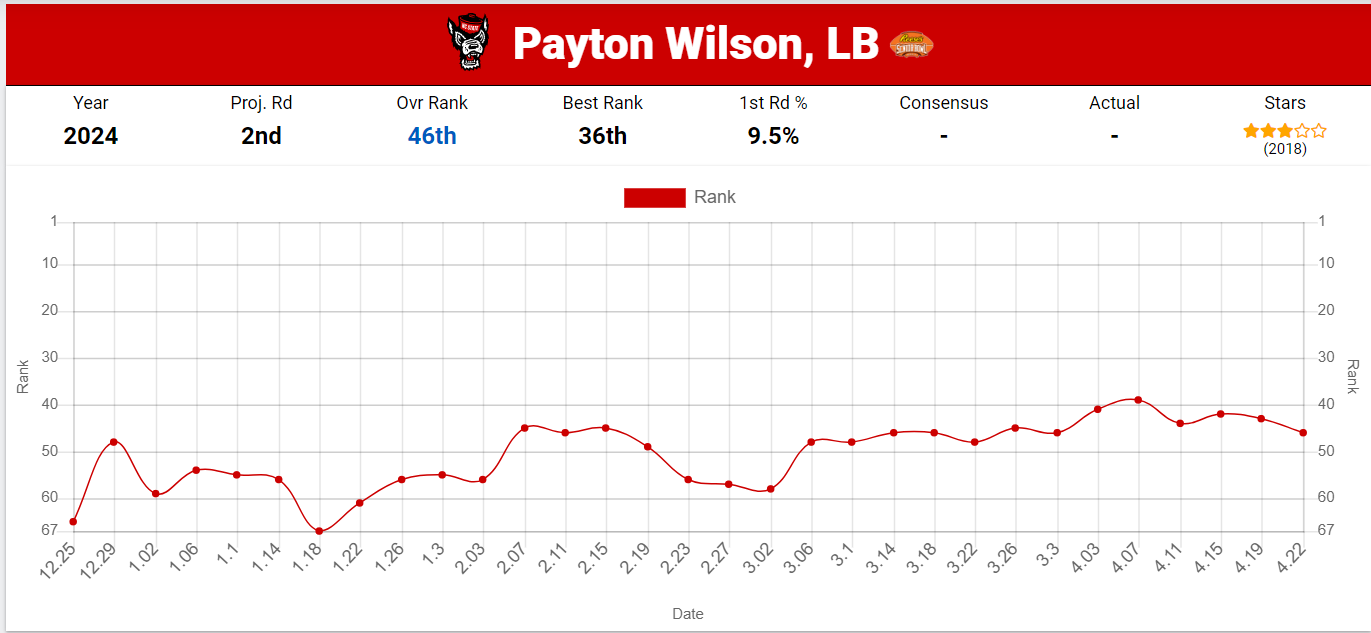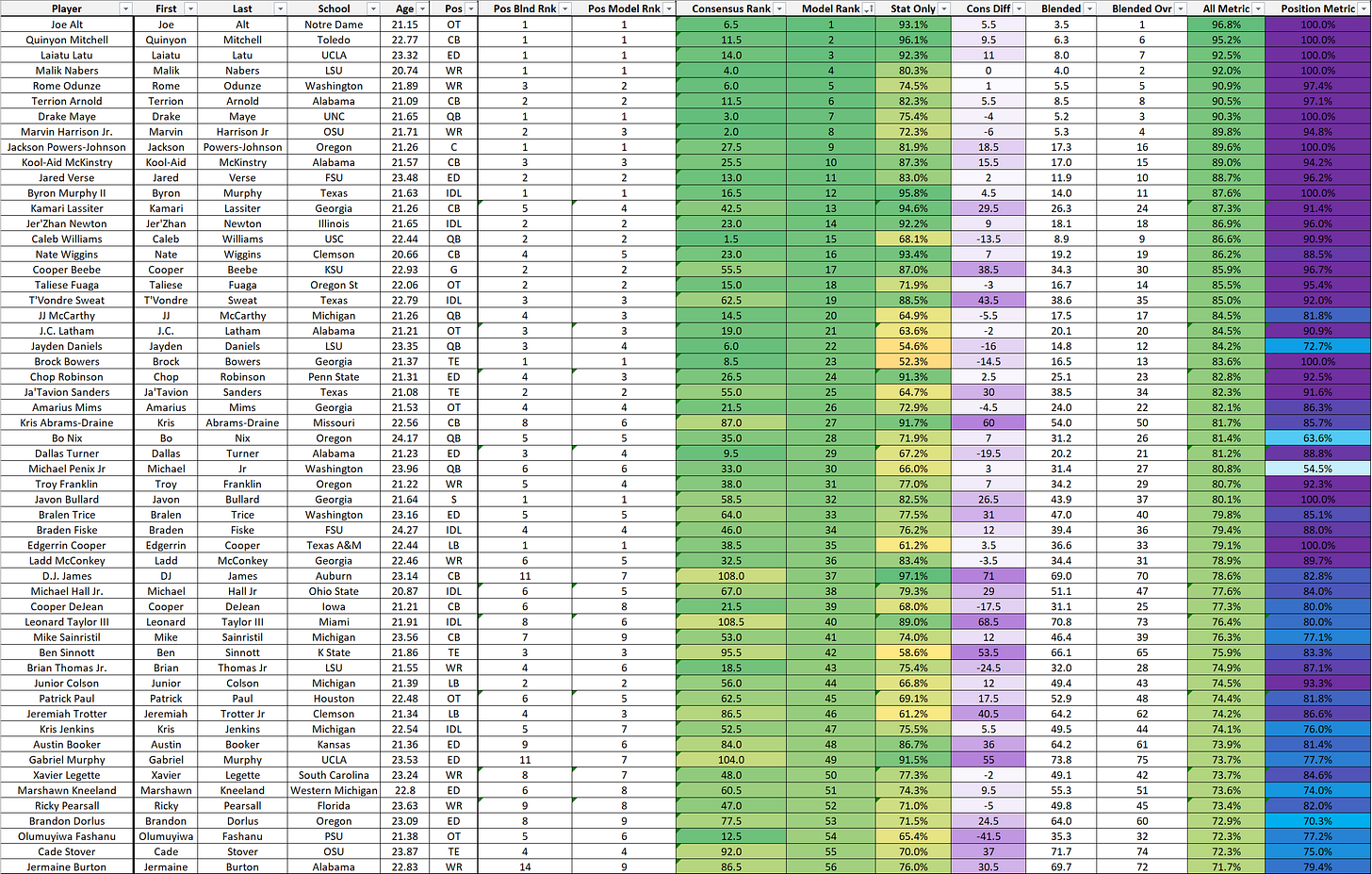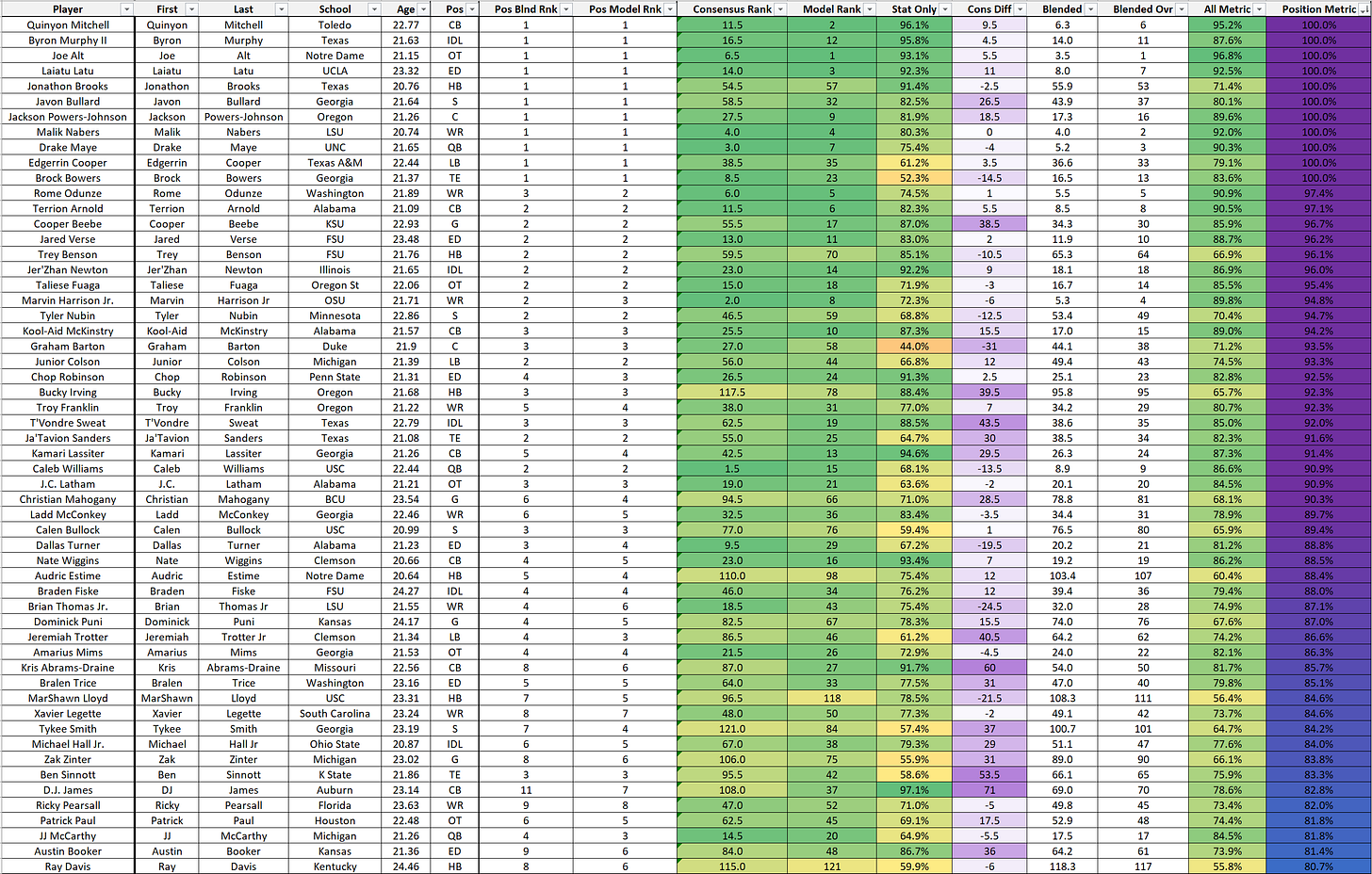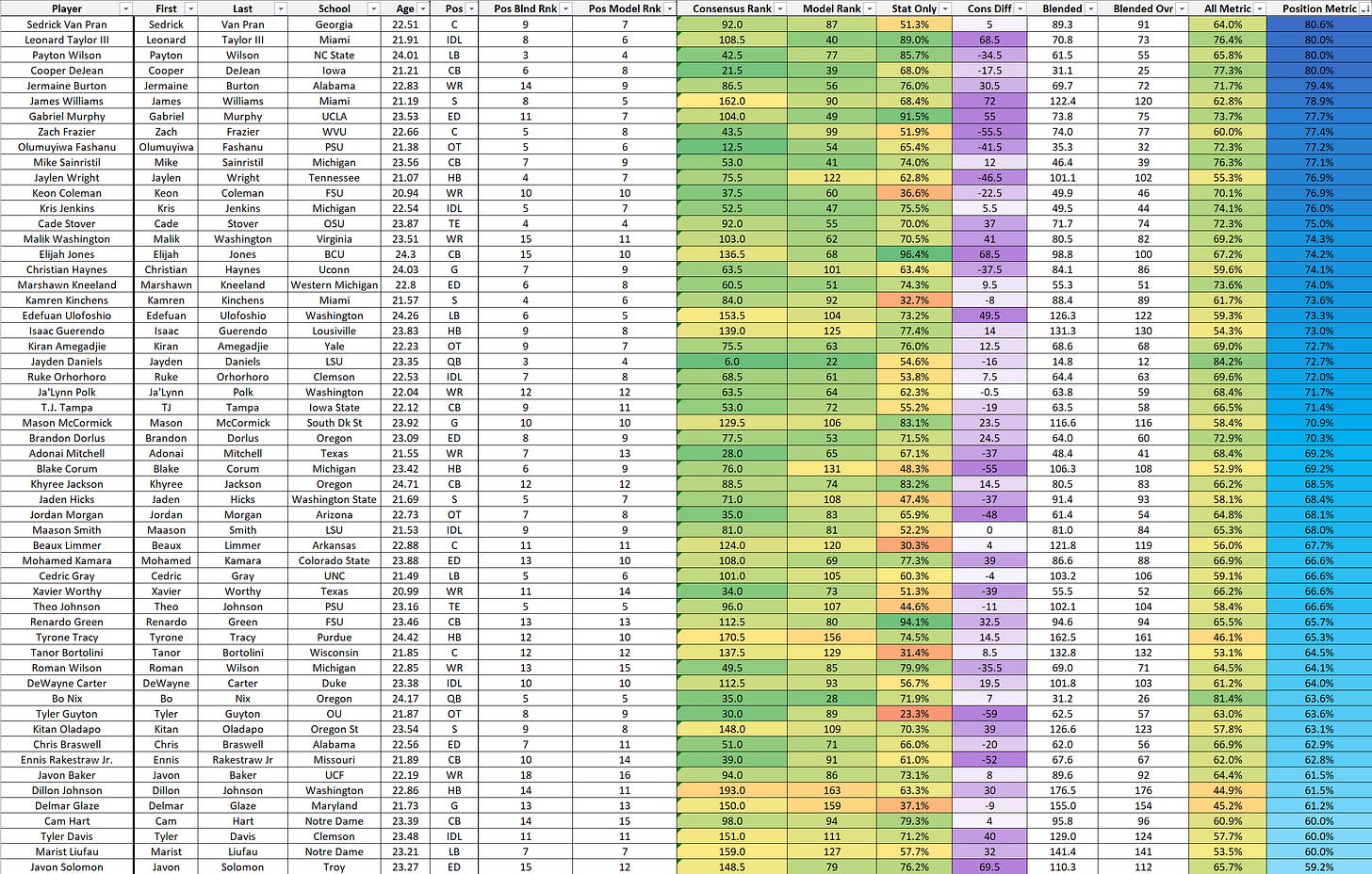2024 NFL Draft Scouts + Stats Model
I have no grand reasoning or urging to do so other than wanting to see what happens, so I tried building a draft model for the 2024 NFL draft. I’m not a data scientist, a math major, or work in computer science. There will be no serialized models, leave-one-out cross-validations, XGBoost was never run, and no R scripts will be harmed in the production of this model.
What I am good at instead is forced marching myself into data collection through sheer will and free time, compiling either manually or automatically a broad aggregation of stats. That’s both the easy part (it’s all already there to be grabbed) and the hard part (it takes time and effort to grab).
The idea of naming it Scouts + Stats was to try to blend both the film side and the stat side. In this day of sports, regardless of the individual sport itself, we live in an era where stats cannot live without film, and film without stats. Much like the impending AI revolution to be, it’s not going to be a simple as “AI will replace (job category).” Instead, it will be (job category) that works with AI and (job category) that doesn’t. Lawyers that use AI, lawyers that don’t. Financial analysts that use AI and big data, financial analysts that don’t. Teams that use big data, teams that don’t. The camps that are in the inclusive category will be the winners.
But you cannot build a draft model solely on data, because in many cases, data lives without context and outside the physical world. And in things like sports, the physical world matters. So building a draft model without including the film and human evaluation aspect of draft prospects is to be only half-conscious and willfully blind.
But one person (outside of perhaps Dane Brugler of The Athletic) cannot watch every snap of every draft eligible prospect and come to some consensus ranking. And I’m not sure you’d want that to be your sole input too. A single person has their own biases and flaws. But that isn’t to say the data itself, though objective, is flawless or solely reliable. A merging of the two is appropriate.
So what I’ve done is gathered wide ranging data points that include for every prospect listed (273 players) various things such as position, age, consensus big board ranking, PFF stable metrics based off PFF grades, and a few other stats and info I was able to get access to.
One thing I think is important for calibration is the consensus draft rankings. History says the best singular evaluator for picking players in the draft is staying close to the consensus big board. NFL teams are generally pretty good at putting players into their correct tiers and range. For instance, NFL teams and scouts are generally good at figuring out who the best handful of receivers are in the draft, but they can’t always pick the right order. Henry Ruggs, Jerry Jeudy, CeeDee Lamb, Jalen Raegor, Justin Jefferson, Brandon Aiyuk, Michael Pittman, and Tee Higgins all went within ~20 picks of each other. Looking back, the order was wrong, even if the “right” receivers were accurately grouped. In hindsight, Justin Jefferson should have been the first receiver taken (heck he probably should have been the 2nd overall pick…), but he was the 5th. Still, he was a first rounder and a consensus top 20 prospect. NFL teams were right overall, but wrong around the edges.
And I think that’s where a draft model for someone without any skin in the game (ie: not working for a team) should try to focus. Not trying to be bold and say “this guy that is 220th on the consensus board should be the first overall pick!” but instead, trying to move players up or down from their consensus ranking based on factors beyond purely just scouting only evaluations.
Which is why I think the consensus big board should work as a bit of a brake pedal for a model, being the central feedback for saying “hey, you might be wrong here…”. That isn’t to say my draft model doesn’t have some bold takes. But instead, what I think is best is to use the model as a way to try to re-order players on the consensus board, to try to put a Justin Jefferson closer to the 1st WR taken rather than the 5th. But that isn’t to say the draft model is imperfect, and in fact, you should be weary of the model if it says that the 220th player should be taken 1st overall and that it might have that player wrong.
One other note that I’ve gotten as feedback and validated with my model, QBs are hard to not only rank on a big board, but also model as well. Steve Palazzolo at PFF has built a draft model that has a pretty good hit rate based off the deep pool of information he has at his disposal, and even he says his own model struggles with quarterbacks. There are a dozen reasons for this that you can probably think of and won’t be discussing here (though I will include quarterbacks just for completion purposes).
Okay, all that said, here are the top 80 players according to the Scouts + Stats model (I’ll go position by position in a bit):
Joe Alt is the best player in the class by the model, but it isn’t adjusted for positional value intentionally. I’m not advocating for taking Joe Alt at first overall (or any non-QB really). But instead, by the model, Alt is highly deserving of his consensus big board rank of 6th overall. He’s maybe even slightly underrated by the smallest amount.
The model is very high on two players: Quinyon Mitchell from Toledo and Laiatu Latu from UCLA. Both were incredibly productive in college and in predictive stats, rank in the top 20 of the consensus board (remember we use this as a calibrator), and have been dinged for respective issues. Mitchell’s explanation is easy: not only did he not go to a big school, it wasn’t even a power five school. If he had gone to, say, Clemson, I think he’d be discussed as the best defender in this class. Latu’s ding is a little more complicated. While it’s easy to say he is simply a medical issue, it’s a bit deeper than that and has a long backstory. But it’s worth noting he has been completely healthy the past two seasons at UCLA.
One other note I think worth mentioning here is Caleb Williams at 9th, with Drake Maye above him at 3rd. There are teams that have Maye over Williams, and Nate Tice at Yahoo/The Athletic has it in that order too. Both are top five prospects on the consensus board, so really it’s Williams’ rank at 9th (seven spots below his big board rank) that is a little more interesting than Maye at 3rd (equal to his big board rank).
PFF highlighted some of his issues in a recent article:
Obviously, Williams excels as an overall thrower in most situations, but one thing he’s struggled at in his career is avoiding negative plays and sacks. Compare that to Drake Maye, who is about as good as Williams has been (if not better in certain situations) but is a little better at avoiding sacks, and a lot better at avoiding negatives.
Some other standout model vs board players:
Higher on:
CB Kris Abrams-Draine (Missouri) 49th model rank vs 87th big board
CB D.J. James (Auburn) 70th model rank vs 108th big board
DT Leonard Taylor III (Miami) 73rd model rank vs 109th big board
TE Ben Sinnott (Kansas State) 65th model rank vs 96th big board
DT T'Vondre Sweat (Texas) 35th model ranks vs 63 big board
ED Gabriel Murphy (UCLA) 77th model rank vs 104th big board
G Cooper Beebe (KSU) 29th model rank vs 56th big board
ED Bralen Trice (Washington) 40th model rank vs 64th big board
Lower on:
OT Troy Fautanu (Washington) 69th model rank vs 19th big board
ED Darius Robinson (Missouri) 66th model rank vs 33rd big board
OT Kingsley Suamataia (Yale) 76th model rank vs 43rd big board
CB Ennis Rakestraw Jr. (Missouri) 68th model rank vs 39th big board
OT Tyler Guyton (OU) 57th model rank vs 30th big board
WR Roman Wilson (Michigan) 71st model rank vs 50th big board
OT Jordan Morgan (Arizona) 55th model rank vs 35th big board
OT Olumuyiwa Fashanu (PSU) 32nd model rank vs 13th big board
Positional Boards
Quarterbacks
Okay, now on to the positional boards. Sorry, I’m not going to be making a GT Table for every position with pretty columns and logos, you’ll just have to enjoy the Excel version with some formatting.
As foretold earlier, Drake Maye is QB1, and moving left to right in the columns can help give some clarity as to why.
The first few columns are self-explanatory (player name, school, age, and position). Then we need to start diving into some explanations for columns.
“Blended” and “Blended Ovr” refer to the rank of blending the “Scouts” and the “Stats” in the “Scouts + Stats” model. It’s a 45%/55% weight to the Scouts/Stats. The reason for the slight over-tilt to the stats side is for two reasons: 1) we want to try to identify players who are +/- spots better than their big board rank based off non-big board underlying metrics and 2) the “Stats” part of the model includes in part the consensus big board as a brake pedal, so we are already including the big board in the blend even at zero weight to the big board itself.
“Pos Bldn Rnk” refers to the players rank at their respective position for the blended Scouts + Stats model, the core model driving the final rankings. This should be in order when I post the snapshot because it’s grouped by position and then ordered by blended rank overall.
“Pos Model Rnk” is the positional rank is the positional rank of the player based solely on the model. The “model” does not include the blending back of the big board.
“Consensus rank” is as it sounds, the rank of the player on the consensus big board. I actually used two aggregate big boards. One from NFL Mock Draft Database, which has 163 big boards included in it. The second is from the always useful Arif Hasan consensus big board which he does some weighting to correct gaps between rankings on big boards (you can read more about it on his linked page). A note: if a player didn’t appear on Arif’s top 300, then I just used the NFL MDD spot for both.
“Model rank” is the players overall rank using the model
“Stat only” is the players percentile aggregate metrics based solely on stats like production, age, and projections.
“Con diff” is the players difference between consensus big board rank and model only rank.
“All metric” refers to a players overall percentile rank for stats, age, production, projection, and big board rank.
“Position metric” is a players rank of the all metric as a percentile in his position group. So a player with a 100th percentile (technically it should be 99th because there is no 100th percentile) means he had the highest score amongst his position in the all metric category. Basically, think of this as a way to see how a player scores based on age, stats, consensus rank, and projection within his position.
So for instance, Jayden Daniels is the 4th best QB on just looking at how he does vs his QB draft peers, but because for the blended model rankings (the final ranking), he gets a boost to QB3 because he’s the 6th rank player on the consensus big board.
Here is how it looks if we sort just players within position group and don’t tilt back towards the overall board a little more beyond the inherent tilt already in the stat side of the model:
Maye and Williams are in their own tier (purple), J.J. McCarthy is in the next tier, then Daniels, then Nix, then Penix Jr. You’ll notice the sort order is the same as the all metric, because the position metric is just the percentile rank of the all metric, just trying to show the difference in gap between players in their position.
Wide Receivers
From a model perspective only, it would rank the Big Three as Nabers-Odunze-Harrison Jr. At one point leading up to this post, Odunze was WR1 but after doing some calibration and sanity checks, Odunze “fell” to WR3. By the stats only model, he would be WR2. Malik Nabers, regardless of pure model only or blending in consensus rank, he is WR1 in this class, just a hair ahead of Harrison Jr. This may seem like an outlier, but there are teams with Nabers ahead of MHJr and it wouldn’t be an upset if Nabers was picked before Harrison.
The model is lower on Brian Thomas Jr (good but not great stable metrics, middle of the road projection), AD Mitchell (same story as Thomas Jr but a little worse), Xavier Worthy (even worse production), and Roman Wilson. It’s also lower on Malachi Corley of Western Kentucky, a player I am actually personally high on despite that, provided Corley goes in the right round (late 2nd/early 3rd) and is used as a complimentary piece than a WR1 or low-WR2. The model says he’s a late 3rd rounder whereas the big board says he’s a late 2nd.
The model is high on Jermaine Burton, Malik Washington, and Tahj Washington. Burton makes sense, his tape is great and he was productive, but off field issues (such as striking a fan) have him not only down on big boards, but probably entirely off the boards of some teams altogether. Malik Washington has above average stable metrics and projection, the model seeing him as a closer to a 2nd round pick than a 4th (I’d really like to know his PFF GAS score but his RAS score was good)
I’m not advocating for taking him with the 61st pick, but more so that he should be closer to that spot than where he is on the consensus big board.
Tahj Washington had some of the best stable metrics for any receiver in the class, which boosts his projection as well. He’s also slightly younger than the average WR prospect. Like I’ll say many times here, it’s not as if the model is saying to take him in the first, but instead, it’s arguing he’s 5-10 spots too low in the WR rankings.
Tight Ends
I can’t prove it because it’s not like I’ve been doing Scouts + Stats Model updates on here or Twitter for months (though I’ve teased some stuff out), but the model has been high on Ben Sinnott from Kansas State since inception. And it’s what caused me to tweet out some tape of his back in mid-March as I was creating the model.
Sinnott has also been climbing up on the consensus big board too, going from the 140s in February to now his final spot near 100th.
He went from being a 5th or 6th round pick, to being mocked as high as the 39th pick at PFN (that’s too high to take him but still, shows his steam).
Brock Bowers is TE1, even if the model doesn’t love him as much as the consensus board where he is ranked 9th vs 23rd on the model.
The model does love Ja’Tavion Sanders, and puts him neck-and-neck with Brock Bowers. Sanders is the youngest tight end prospect on the board, and had better stable metrics than Bowers in 2023. He tested very poorly from a size and explosive category. I don’t use RAS in the Scouts + Stats model, mainly because as it’s creator Ken Platte will tell you, high RAS doesn’t = great player outright. Instead, it just has a bias towards good players, in that good players often have higher RAS scores. I just couldn’t quite find the right fit for it in my model, and not to mention combine scores are losing weight in the industry as players test less and teams use things like PFF GAS instead for play speed vs testing speed.
Cornerbacks
As I said earlier, the model has Quinyon Mitchell as not only the best corner, but the 2nd best player in the entire draft. It’s only when you bake back in the consensus rankings that he gets throttled a bit. Mitchell was 99th percentile or better in almost every single stable metric, the only one he “lacked” in was coverage from the slot. But he’s a pure outside corner type, so even if he’s merely good instead of great in the slot, he’s still best at what he does outside. The only nitpicks you can make really are that he played in a weak conference (and PFF grades and stats are not adjusted for opponent) and that he isn’t super young (he’s 50th percentile for cornerback age).
All-in-all, the model has four corners in the top 16 players, with Kamari Lassiter being a stand out vs his consensus rank. The model thinks he’s closer to a 1st rounder than a mid-2nd rounder like he’s being ranked. He’ll be great value if he goes on day two at any point.
The model also really loves Kris Abrams-Draine from Mizzou (and I promise I didn’t put any thumbs on the scale as a Missouri fan). He performed at a similar level as Mitchell and is about the same age. The projection system says he is the 2nd best corner in the draft.
A couple more guys the model likes relative to their big board rank:
Kamal Hadden (Tennessee)
D.J. James (Auburn)
Elijah Jones (BCU)
And on the other side, guys the model likes a little less
Ennis Rakestraw Jr. (Missouri - see I didn’t rig it)
Max Melton (Rutgers)
Kalen King (Penn State)
Edge Rushers
As mentioned earlier with Mitchell, Laiatu Latu (UCLA) is seen as one of the best players in this class. He had just incredible production when it comes to stable NCAA to NFL stats, with the only ding being he was just fine as a run defender. But that won’t be what he’s asked to do in the pros. He’s a little older by nature of having the medical issues, but he’s not egregiously old like Xavier Thomas (Clemson) who turn 25 late in the 2024 season. And for Latu (though it isn’t baked into the stats and projections), he played in a good conference and had individual matchups against NFL caliber players like Jordan Morgan, Connor McLaughlin, Taliese Fuaga, and Andrew Vorhees.
The model is lower on Dallas Turner of Alabama, who was fine production wise as a pass rusher, but poor as a run defender. Turner is very young, and I think “young and developmental” is something the draft model might struggle with. Turner might be the first defender taken, but the draft model would say be cautious and patient with him.
A couple more guys the model likes relative to their big board rank:
Austin Booker (Kansas)
Gabriel Murphy (UCLA)
Javon Solomon (Troy)
Grayson Murphy (UCLA) - he and Gabriel Murphy are twins brothers, in case you thought this was a typo/repeat
And on the other side, guys the model likes a little less
Darious Robinson (Missouri)
Jonah Ellis (Utah)
Chris Braswell (Alabama)
Interior Defensive Line
Really not a lot of major deviation at the top, of the guys in the top 100 consensus board, most are within 10 spots of the draft model too.
The model is a big fan of T’Vondre Sweat, having him more like a mid-1st rounder than a late-2nd. Sweat was the most productive defensive tackle in the draft when you account for his teammates.
https://twitter.com/Shauncore/status/1782516631719035226
The model is also a fan of Leonard Taylor III from Miami. He’s a young player who played well in a good conference, and his stable metrics give him one of the better projections over the next few seasons.
A couple more guys the model likes relative to their big board rank:
Michael Hall Jr. (Ohio State)
Tyler Davis (Clemson)
Khristian Boyd (Northern Iowa)
And on the other side, guys the model likes a little less
Mekhi Wingo (LSU)
Justin Eboigbe (Alabama)
McKinnley Jackson (Texas A&M)
Running backs
Weird class for running backs, as none are in the consensus top fifty, and the draft model agrees. The four best backs in the class are Jonathon Brooks, Trey Benson, Bucky Irving , and Audric Estime when we don’t have the model anchor back to draft ranking.
Not going to spend much time writing this one up, as a half back shouldn’t be taken until the late 2nd round given this class, so we are just arguing between spots on day two and three, for guys that aren’t highly ranked to begin with.
I will say, the model does like and think Jonathan Brooks is the best back in the class, but even then it isn’t much higher on him than his big board rank. And in fact, his model rank is 2.5 spots lower.
A couple more guys the model likes relative to their big board rank:
Dillon Johnson (Washington)
Kimani Vidal (Troy)
Kendall Milton (Georgia(
Blake Watson (Memphis)
And on the other side, guys the model likes a little less
Jaylen Wright (Tennessee)
Blake Corum (Michigan)
Will Shipley (Clemson)
Braelon Allen (Wisconsin)
Offensive Tackles
If the model loves the cornerback group this year, it hates the offensive tackle class apparently, even though it think Joe Alt is the best player in the draft.
For a few first round like tackles (Alt, Fuaga, Latham, and Mims) the model thinks they are about in the right spot. But then it is very low on Fashanu, Morgan, Guyton, and particularly Troy Fautanu from Washington.
Fautanu isn’t young (20th percentile age for OTs), graded very poorly in the run game, was middle of the road as a pass blocker, and moving to a more “normal” offensive environment outside of Washington (the Huskies used a ton of play action and had one of the quicker times to throw for power five schools) hurts his projection.
A couple more guys the model likes relative to their big board rank:
Patrick Paul (Houston)
Kiran Amegadjie (BYU)
Garret Greenfield (South Dakota State)
And on the other side, guys the model likes a little less
Roger Rosengartern (Washington)
Blake Fisher (Notre Dame)
Javon Foster (Missouri)
Will be very eagerly waiting to see how this looks next year, as it may mean OTs and CBs need a re-calibration if they are massive misses collectively.
Interior Offensive Line
Ended up lumping these two together positionally, even if I have their positions listed out in the image above. I typically went with what the player was listed as playing on the consensus big board.
Jackson Powers-Johnson headlines the IOL class, coming in as a top 10 player (reminder that it isn’t saying to take him at 10th, just that the model think he’s better than his consensus spot). JPJ was dominate in pass blocking and zone run plays. He seems to be a better mover than he gets credit for. He’s also the youngest interior linemen in the class and one of the 25 youngest overall.
Cooper Beebe is the other standout from a bullish perspective, hopping 55 spots and cracking the top 20.
Graham Barton, it pains me to say, isn’t loved as much by the model. I know some folks have draft crushes on him, but the model says he’s more like a second round pick rather than a first.
The last callout is Zach Frazier of West Virginia, who the model thinks is about two rounds too high.
A couple more guys the model likes relative to their big board rank:
Christian Mahogany (BCU)
Zak Zinter (Michigan)
Mason McCormick (South Dakota State)
And on the other side, guys the model likes a little less
Christian Haynes (UConn)
Brandon Coleman (TCU)
Isaiah Adams (Illinois)
Linebackers
Another weird class, like halfbacks, were both the consensus board and model don’t think the position group has a first rounder (even ignoring positional value).
Payton Wilson has gained some steam, climbing up from nearly the 60s to at peak, 36th.
But the model agrees with the consensus board overall, Edgerrin Cooper is the best (or expected to be) linebacker. And though the consensus big board has Wilson in a close second, the model sees Michigan backer Junior Colson in the spot.
A couple more guys the model likes relative to their big board rank:
Jeremiah Trotter (Clemson)
Edefuan Ulofoshio (Washington)
Marist Liufau (Notre Dame)
Tyrice Knight (UTEP)
And on the other side, guys the model likes a little less
Tommy Eichenberg (Ohio State)
Trevin Wallace (Kentucky)
Safeties
The consensus board says Tyler Nubin is the best safety in the class by a non-small amount. The draft model disagrees, but not by a huge amount. Instead, it disagrees with Javon Bullard’s ranking, saying that no he is the best safety in the class and by a good bit.
Bullard finished in 90th percentile or better in several pass coverage stable metrics, but was just meh in the run game. He’s very young, and his reps at presumably free safety or in a more coverage based role give his projection a higher boost than Nubin, who is a more box type safety.
A couple more guys the model likes relative to their big board rank:
Jeremiah Trotter (Clemson)
Edefuan Ulofoshio (Washington)
Marist Liufau (Notre Dame)
Tyrice Knight (UTEP)
And on the other side, guys the model likes a little less
Tommy Eichenberg (Ohio State)
Trevin Wallace (Kentucky)
Model Only Players
Below is a list of players that are liked strictly based on the draft model, which includes a little bit of the consensus draft board rank, but isn’t the pure blended rank that is nearly an even split between the model and big board.
Stat Only Players
Here are the players with just the best collection of stable metrics, projections, and production, ignoring consensus big board completely (reminder: the model rank includes the big board partially in it, whereas stat only is just stats).
Purple/Blue Players
And finally, here is what I am calling purple or blue players, which looks at how well a player scores when you compare him to just his position and where he ranks there. Again a reminder, “blended” anchors the model back to the big board a bit. But stat only, all metric, and position metric disconnects it a bit from the big board (but it still uses the big board for some information).
Purple colored players are the best at their position. They typically score 90th percentile better than their positional peers when you consider age, performance, projection, and their consensus big board rank.
One thing here is that someone like Jayden Daniels is a blue level player, which sounds like he isn’t liked as much. That is somewhat true (the blended model has him as QB3), but it’s mainly just the model likes Maye and Williams more.



